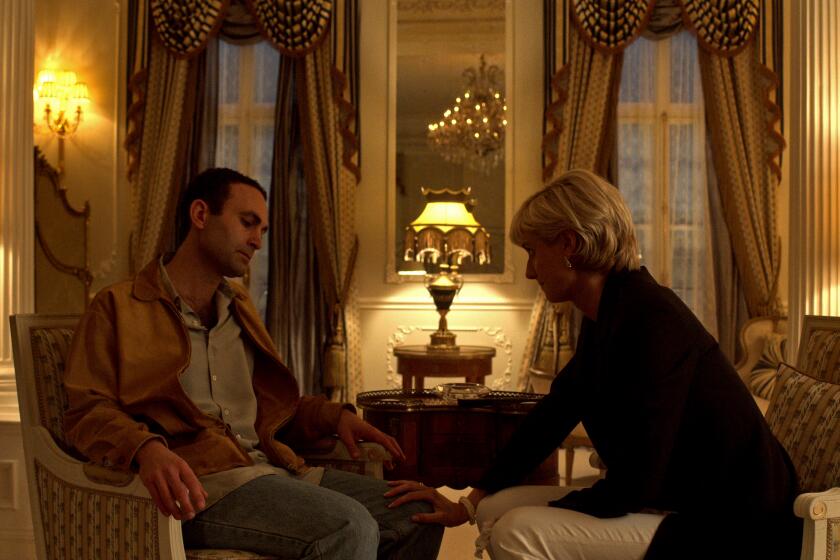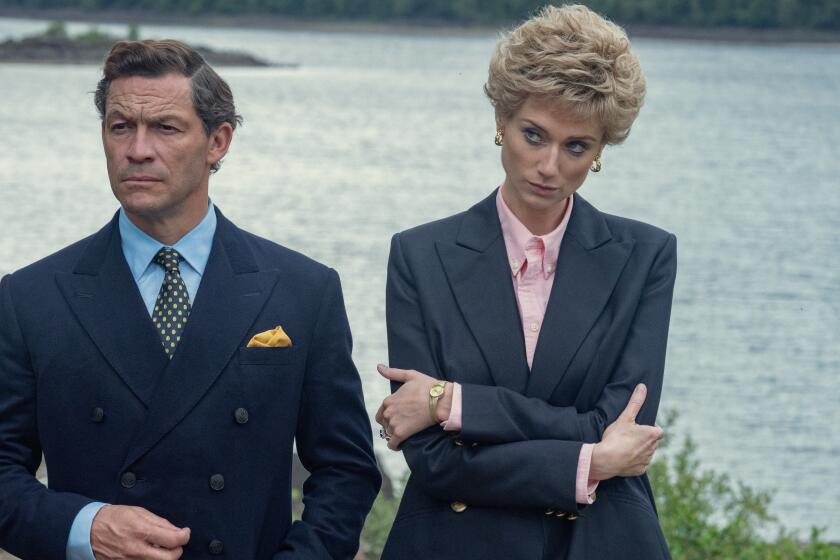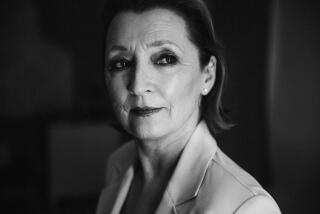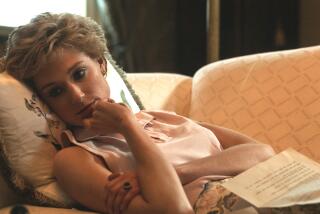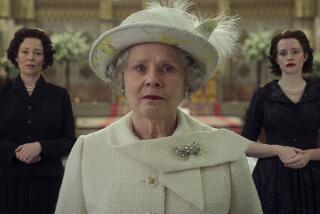Aided by a coach, Elizabeth Debicki transformed her gait and gaze into Diana’s on ‘The Crown’
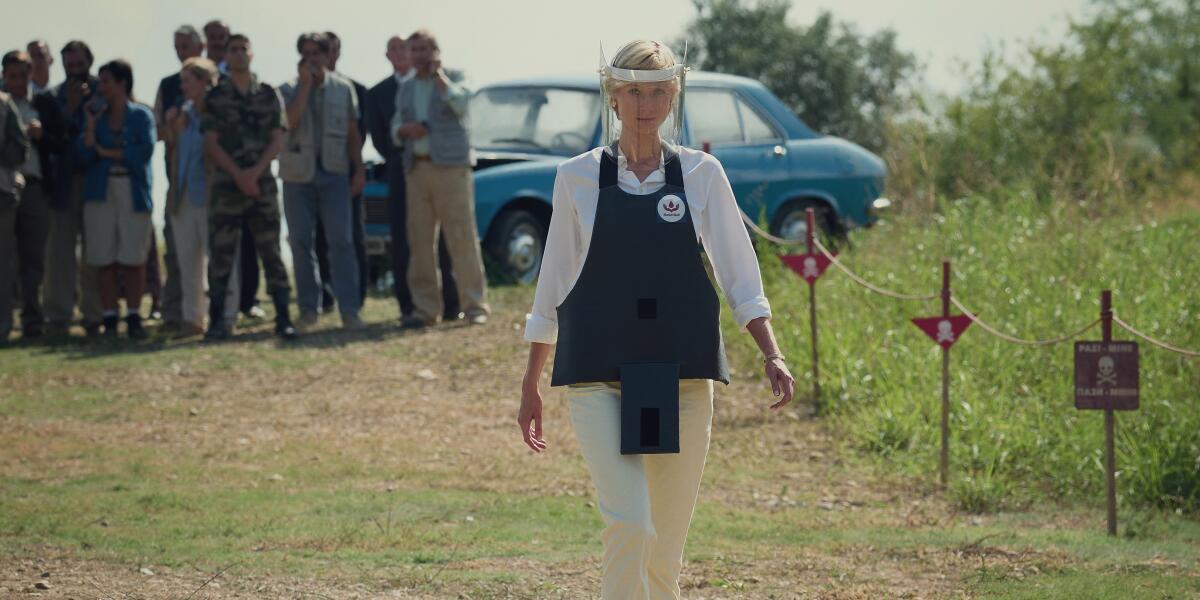
- Share via
During her 16 years in the spotlight, Diana, Princess of Wales, was one of the most photographed women in the world. Part of what endeared her to the public and made her so irresistible to the press were her distinct, unusually expressive mannerisms — the bashful head tilt, the nervous lip-biting, the tactile way she interacted with her sons.
The challenge for any actor playing such a recognizable public figure is how to capture their essential movements without descending into caricature. For Elizabeth Debicki, who stars as Diana in the final season of “The Crown,” that task was made less daunting by movement coach and choreographer Polly Bennett.
Bennett has worked on “The Crown” since Season 3, helping the cast fine-tune their physical performances and understand the origins of each character’s unique gestures, posture and gait.
“We find the reasons why movements happen,” Bennett said in a recent video chat from London. Originally trained as a dancer, Bennett encourages actors to be as conscious of their bodies as they are of their dialogue and accents.
“Actors spend a lot of time by themselves, taking in lots of information and not actually being able to practicalize or physicalize what they’re doing,” she explained. “Especially on programs like ‘The Crown,’ I invite them in and say, ‘Tell me everything you’ve been looking at.’ And then we work out how to actually turn that into something physical, so that you’re not just stuck in your head going, ‘I’ve got to act like I’m a famous person.’”
The first part of Season 6 of Netflix’s “The Crown” examines Princess Diana’s final weeks from her perspective and the media frenzy that ensued after her death.
Most people, when asked to do an impression of Diana, probably would tilt their head or attempt a bashful gaze. Bennett’s job “is to unpack that and go, ‘Well, what side does it normally happen on? What is she seeing when she moves her head? What changes in her breath when she is looking a certain way?’” she said. “It is like being a private investigator of a lot of public material.”
In Bennett’s view, it’s useful to consider the way that being as famous as Diana was might manifest physically. “Being seen by lots of people all the time changes your body,” she said. “It changes how you have dialogue with people. It changes where you sit in a restaurant and how you engage with the people you love.”
Bennett operates from the assumption that “everything psychological that happens to us exists in our body,” she said.
The way we carry ourselves is the result of myriad factors, from the sports we played as a child to the food we eat. The goal of this method is to “create a full, rounded character,” Bennett explained. “It is not about mimicking something that already exists. You’re trying to find an authentic truth and a reason why people act the way that they do.”
Debicki said that when she joined “The Crown” in Season 5 — taking over for Emma Corrin, whose depiction of the blushing teenager dubbed “Shy Di” was so uncanny it sparked a meme — she felt nervous and vulnerable. “It was overwhelming,” said Debicki, who prepped by viewing hours of archival footage of Diana.
“There was just an incredible magnetism, an approachability, a very distinct vulnerability that helped us empathize with her unlike other public figures,” said Debicki. “One of the things that frustrated me when I was trying to do my research was I’d sit down with my notepad to take notes. Then I ended up just staring at the screen lovingly and go, oh s—, I have to go back 20 minutes.”
Debicki likens this prep period to standing on a threshold: “You haven’t quite started to try to [perform the character] aloud in front of people. She understood how vulnerable that threshold was, and she just gently helped me get over it.” Debicki and Bennett would review footage and photos together, and identify patterns in Diana’s behavior — noting, for instance, how she “never get out of a car without holding a clutch right up to her chest. We broke it down: Well, obviously that’s because she didn’t want to give photographers an angle,” Debicki said.
For Debicki, who also had experience as a dancer, there was something liberating about collaborating with someone who was so body-focused and could help find what she called the “emotional logic” of her character’s movements — an “incredibly crucial step” in making the show, she said.
The Australian actor is effusive in her praise of Bennett, saying that every time she bumps into Austin Butler at an event, “All we do is talk about Polly. It’s a revolutionary thing to have someone say, ‘I want to help you do this work that you would otherwise have to do on your own.’” (Bennett worked with Butler on “Elvis,” helping him embody the rock ’n’ roll legend’s mannerisms.)
In “The Crown,” Debicki portrayed Diana from 1990 through 1997, a turbulent period that included the demise of her marriage and a series of highly public scandals that tarnished the British monarchy. The first installment of “The Crown’s” final season follows the princess during the last weeks of her life, as she forged a new path outside the royal family, vacationed with her sons in St-Tropez and pursued a whirlwind romance with Dodi Fayed.
“It’s only seven years of her life but such a vivid period of change. She really shifts physically a lot,” said Debicki.
Bennett usually works most extensively with the cast during preproduction, when they’re also meeting with the hair and makeup teams, training with the show’s dialect coach, William Conacher, and rehearsing with directors. She tries to find evocative images or mantras to help them get in and out of character easily and give them “something practical to play,” she said. She also is regularly available on set for the actors. “Me being there is a reminder that they can think with their body as well as their words,” she said.
As the Netflix drama revisits a sordid chapter in royal history at an awkward moment for the monarchy, the Windsors’ allies are coming out against it.
With Corrin as Diana, a visual Bennett suggested was imagining that laser beams were being pointed at Diana’s head — and she’s trying to avert them, like Catherine Zeta-Jones in “Entrapment.” When Debicki took over the part, Bennett asked her to act out scripts from the previous season, “so that she had the experience of being younger Diana and she could kind of grow through the series as Emma had done,” she said.
But they also focused on finding a new physical vocabulary for the character — reviewing footage together and noticing, for instance, how Diana worked crowds. “She reaches to the people at the back, then to the middle, and then normally goes to a child: Back, middle, child. So she is working on three planes of movement, which is probably why people felt so attached to her because they didn’t feel ostracized,” Bennett said. (Charles, in contrast, would usually reach for a man of similar height.)
Debicki, who stands 6 feet 2 inches, also understood what it was like for Diana to be tall. “I know what it means to feel like you want to get on a level” with other people, she said. “Every time you enter a room, you are the shiniest, most luminous thing possible to walk into that opening of an auto parts factory, or you’re around people who are really suffering, for instance. There’s a sense where you feel like the body is trying to not compensate for that.”
She was particularly struck by a famous video of Diana conversing with a blind man — kneeling at his level and offering her face for him to feel. “It’s like, how could you not love that person so much with just that degree of offering and vulnerability?” said Debicki.
In Season 5, they focused a lot on the “revenge dress” sequence in Season 5, noting the confidence with which Diana stepped out of the car. “She doesn’t stop. She doesn’t check her handbag. She doesn’t look down. It’s a really hard thing to do,” said Bennett. She encouraged Debicki to think like an owl, an animal that sits very still but needs to be able to launch off quickly.
“Images like that, and research like that, means that Elizabeth isn’t having to play ‘get out of the car and tell the world to have a look at this.’ She’s playing being an owl, which is a lot more freeing as an actor,” Bennett said.

Season 6 presents an even more complicated Diana, liberated from the confines of royal life but also under siege from paparazzi. Her intense attachment to her sons, Prince William and Prince Harry, is apparent through their physical connection — Bennett had Debicki imagine an electric current tying them together. But she’s also shutting down, trying to recede from the view of the photographers — when she’s not posing for them.
Season 6 also offers an imagined version of the private Diana as she pursued a relationship with Dodi. We see the couple in cloistered, luxurious spaces: in a suite at the Ritz Hotel and aboard the Fayed family yacht. Debicki and Bennett talked about how Diana would be in contact with the furniture on the boat — touching the walls, playing the piano. “All of these things that she’s in contact with root her to the ground, where she is in contrast to the feeling of the public Diana, which is unrooted,” said Bennett.
Princess Diana was thrust into the global spotlight when she married Prince Charles. Emma Corrin, the new star of ‘The Crown,’ can relate.
They prepared for the scenes of Dodi and Diana leaving the Ritz Hotel on the night they died in a car accident by reviewing the grainy security-camera footage that captures some of their final moments. A detail that stood out: how Diana is in contact with Dodi and the objects around her. “That might have been an incidental thing,” said Bennett, “but we can take that as the idea of her trying to hold on to whatever’s tangible when things get ethereal and fearful.”
They also took note of her outfit — a slim black blazer and white pants. “She’s confining herself,” Bennett said. “What she’s not doing is wearing a ballgown and waving to the press. So sometimes looking at what they’re not doing is more revealing than what they are doing.”
Bennett also works with the rest of the cast to identify and unpack signature movements. With Dominic West, who plays Prince Charles in Season 5 and 6, they envisioned a crown floating just above his head to explain the heir’s slightly hunched posture. “And that’s a really helpful image for him psychologically, as somebody who’s maybe becoming king, but also gives a reason for that stoop that we can see in Prince Charles’ body,” explained Bennett. That way, she said, “He’s playing something active rather than just stooping for the sake of it.”
Bennett and Imelda Staunton, the third actor to play Queen Elizabeth II in “The Crown,” decided that the queen should stand with her big toes firmly planted in the floor, which “gives a little zip forward in your spine,” Bennett said. “She is always ready to move off, because she doesn’t want to stick around. She’s got things to do.”
More to Read
The complete guide to home viewing
Get Screen Gab for everything about the TV shows and streaming movies everyone’s talking about.
You may occasionally receive promotional content from the Los Angeles Times.
